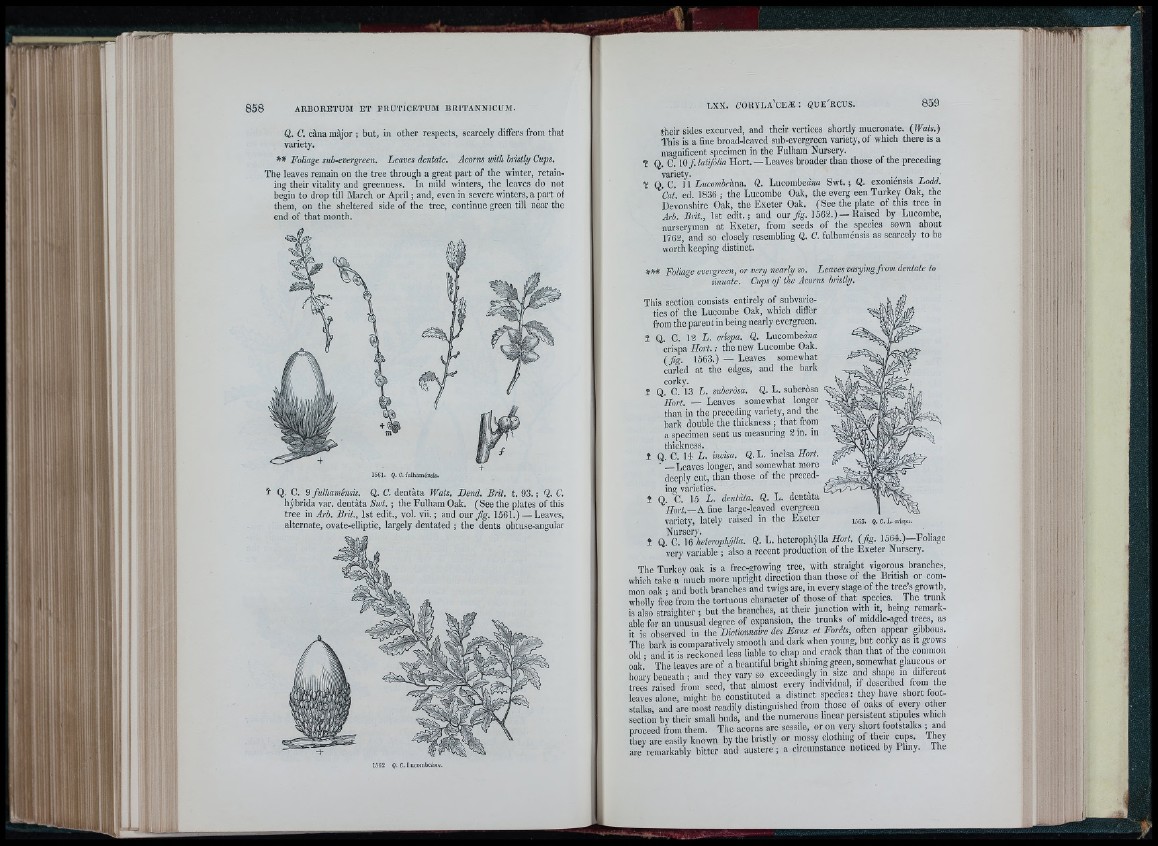
- t
8 5 8 ARBORETUM E T FR U T IC E TUM B R ITANN ICUM ,
Q. C. càna màjor ; b u t, in o th e r respects, scarcely differs from that
vai'iety.
0* Foliage suh-evergreen. Leaves dentate. Acorns with bristly Cups.
T h e leaves remain on th e tre e through a great p a rt o f th e winter, retaining
the ir vitality and greenness. In mild winters, th e leaves do not
begin to drop till March o r April 5 and, even in severe w inters, a i)art oi
them, on th e sheltered side o f th e tre e , continue green till near the
end o f th a t month.
1561. Q. C. fulhaménsis.
¥ Q. C. 9 fulhaménsis. Q. C. d en tà ta Wats. Dend. B rit. t. 93. ; Q. C.
hybrida var. d en tàta Swt. ; th e Fulham Oak. (S e e th e plates o f this
tre e in Arb. B rit., 1st edit., vol. vii. ; and o u r Jig. 1561.) — Leaves,
alternate, ovate-elliptic, largely d entated ; th e dents obtuse-angular
1562 Ç, C. l.uci
LX X. c ü r y l a ' c e æ : q u e ' r c u s . 8 5 9
th e ir sides excurved, and th e ir vertices shortly mucronate. (W a ts.)
This is a fine broad-leaved sub-evergreen variety, o f which th e re is a
ma<mificent specimen in th e Fulham Nursery.
¥ Q. C ? f.latifòlia H o rt. — Leaves bro ad er th an those o f th e preceding
variety.
■ï Q. C. 11 Lucombekna. Q. Lucombea«« Swt. ; Q. exoniénsis Lodd.
Cat. ed. 1836 j th e Lucombe Oak, th e everg een Tu rk ey Oak, th e
Devonshire Oak, th e E x e te r Oak. (S e e th e pla te o f this tre e in
Arb. B rit., 1st e d it.; and our fig . 1562.) — Raised by Lucombe,
nurseryman a t E x e te r, from seeds o f th e species sown about
1762, and so closely resembling Q. C. fulhaménsis as scarcely to be
worth keeping distinct.
*** Foliage evergreen, or very nearly so. Leaves varying from dentate to
sinuate. Cups o f the Acorns bristly.
This section consists entirely o f subvarieties
of th e Lucombe Oak, which differ
from th e p arent in being nearly evergreen.
Î Q. C. 12 L . crispa. Q. Lucombem a
crispa Hort. ; th e new Lucombe Oak.
( f ig . 1563.) — Leaves somewhat
curled a t th e edges, and th e hark
corky.
Î Q. C. 13 L. suberôsa. Q. L . suberosa
Hort. — Leaves somewhat longer
th an in th e preceding variety, and the
bark double th e thickness ; th a t from
a specimen sen t us measuring 2 in. in
thickness.
Î Q. C. 14 L . incìsa. Q. L. incisa Hort.
■ — Leaves longer, and somewhat more
deeply cut, than those o f th e preceding
varieties. i
Î Q. C. 15 L . dentata. Q. L. d en tata
Hort.— A fine large-leaved evergreen
variety, lately raised in th e E x e te r 1.563. q . C. L. ccispa.
Î f c . 7 6 h e t e r o p h m a . Q. L. h eterophylla Hort. (fig . 1564.)—Foliage
very variable ; also a recen t production o f th e E x e te r Nursery.
The Turkey oak is a free-growing tre e , with straight vigorous branches,
which take a much more upright direction than th o se o f th e British or common
oak ; and b oth branches and twigs are, in every stage o f th e tre e s growth,
wholly free from th e to rtu o u s cha ra cte r o f th o se o f th a t species. X he tru n k
is a ls i straighter ; b u t th e branches, a t th e ir ju n c tio n with it being remarkable
for an unusual degree of expansion, th e tru n k s o f middle-aged tre es, as
it is observed in th e Dictionnaire des E a u x et Forets, often appear gibbous.
The bark is comparatively smooth and dark when young, b u t corky as it grows
old • and it is reckoned less liable to chap and crack than th a t of th e common
oak ’ The leaves are o f a beautiful bright shining green, somewhat glaucous o r
hoal-y b en e a th ; and they vary so exceedingly in size and shape in different
trees raised from seed, th a t almost every individual, if described from the
leaves alone, might be constituted a distinct species: they have sh o rt footstalks,
and are most readily distinguished from those o f oaks o f every oth e r
section by th e ir small buds, and th e numerous linear persistent stipules which
proceed from them. The acorns are sessile, or on very sh o rt footstalks ; and
they are easily known by th e bristly or mossy clothing o f the ir cups. They
are remarkably b itte r and auste re ; a circuinstanee noticed by Pliny. The